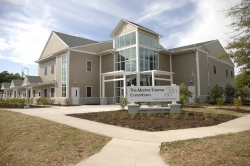Marine Sciences Consortium Opens New Education Campus
Marine Science Consortium, a marine biology education campus, opens a new Wallops Island, Virginia facility for university, college and high school students.

New York, NY, September 21, 2010 --(PR.com)-- Marine Sciences Consortium's new research and teaching campus opens on Wallops Island, VA.
Design of Modern Labs, Housing Inspired by Local Marine Harbor Landmarks; Hands-on Marine Study Programs Attract 5,000 Students of All Ages
The Marine Science Consortium in Wallops Island, Virginia, designed by STV Architects, opened its new, 30-acre, $15-million modern campus this month. The Consortium teaches marine biology and ecology to 5,000 middle and high school students, college students and families. The new campus is expected to attract additional students from the Mid-Atlantic States and across the nation.
“The seven new labs, classrooms, housing facilities and administrative building replace old, WW II Naval barracks that had been used since the Consortium moved to Wallops Island in 1971,” said Amber Parker, executive director of the Consortium. The 23,000 square-foot, LEED-certified Environmental Learning Center serves as the “front door” to the MSC complex, and its glass entrance tower, with a lighthouse-like verticality, gives the facility a recognizable entrance profile. The building has seven separate lab/ classrooms, three regular classrooms, a computer classroom, an outdoor teaching pavilion, bookstore, and administration offices.
“Local landmarks and marine and boat configurations offered clues to an appropriate architecture with simple detailing,” said Stuart Rothenberger, AIA, Senior Vice President at STV. “Materials lend a unified expression to the complex and give it a residential scale.”
The Consortium is comprised of 13 multi-state universities, including eight Pennsylvania State System universities, who collaborate with NASA Wallops Flight Facility, the US Fish and Wildlife and the National Park Service to conduct research and teach about marine and coastal ecosystems, including local fish, crabs, dolphins, dunes and barrier islands. Students are drawn from across the United States, with a heavy concentration of learners from Virginia, Maryland, Pennsylvania, New York and New Jersey. More information at www.msconsortium.org.
STV focused on sustainable strategies, such as: high recycled content (cement, steel and chipped wood products); regionally-sourced material coming from within 500 miles of the site; maximum day lighting; highly reflective roof surfaces and deep roof overhangs; lighting controls with occupancy sensors; task lighting; low flow, dual flush toilet fixtures.
With more than 1,800 employees in 33 offices, STV is a leader in providing architectural, engineering, planning, environmental services and construction management for buildings and facilities, transportation systems, and infrastructure. STV is ranked 44th in Engineering News-Record’s Top 500 Design Firm survey. STV is 100 percent employee-owned and maintains a web site at www.stvinc.com.
###
Design of Modern Labs, Housing Inspired by Local Marine Harbor Landmarks; Hands-on Marine Study Programs Attract 5,000 Students of All Ages
The Marine Science Consortium in Wallops Island, Virginia, designed by STV Architects, opened its new, 30-acre, $15-million modern campus this month. The Consortium teaches marine biology and ecology to 5,000 middle and high school students, college students and families. The new campus is expected to attract additional students from the Mid-Atlantic States and across the nation.
“The seven new labs, classrooms, housing facilities and administrative building replace old, WW II Naval barracks that had been used since the Consortium moved to Wallops Island in 1971,” said Amber Parker, executive director of the Consortium. The 23,000 square-foot, LEED-certified Environmental Learning Center serves as the “front door” to the MSC complex, and its glass entrance tower, with a lighthouse-like verticality, gives the facility a recognizable entrance profile. The building has seven separate lab/ classrooms, three regular classrooms, a computer classroom, an outdoor teaching pavilion, bookstore, and administration offices.
“Local landmarks and marine and boat configurations offered clues to an appropriate architecture with simple detailing,” said Stuart Rothenberger, AIA, Senior Vice President at STV. “Materials lend a unified expression to the complex and give it a residential scale.”
The Consortium is comprised of 13 multi-state universities, including eight Pennsylvania State System universities, who collaborate with NASA Wallops Flight Facility, the US Fish and Wildlife and the National Park Service to conduct research and teach about marine and coastal ecosystems, including local fish, crabs, dolphins, dunes and barrier islands. Students are drawn from across the United States, with a heavy concentration of learners from Virginia, Maryland, Pennsylvania, New York and New Jersey. More information at www.msconsortium.org.
STV focused on sustainable strategies, such as: high recycled content (cement, steel and chipped wood products); regionally-sourced material coming from within 500 miles of the site; maximum day lighting; highly reflective roof surfaces and deep roof overhangs; lighting controls with occupancy sensors; task lighting; low flow, dual flush toilet fixtures.
With more than 1,800 employees in 33 offices, STV is a leader in providing architectural, engineering, planning, environmental services and construction management for buildings and facilities, transportation systems, and infrastructure. STV is ranked 44th in Engineering News-Record’s Top 500 Design Firm survey. STV is 100 percent employee-owned and maintains a web site at www.stvinc.com.
###
Contact
STV Inc.
Axel Bang
914.234.5433
stvinc.com
Axel Bang
914.234.5433
stvinc.com
Categories
